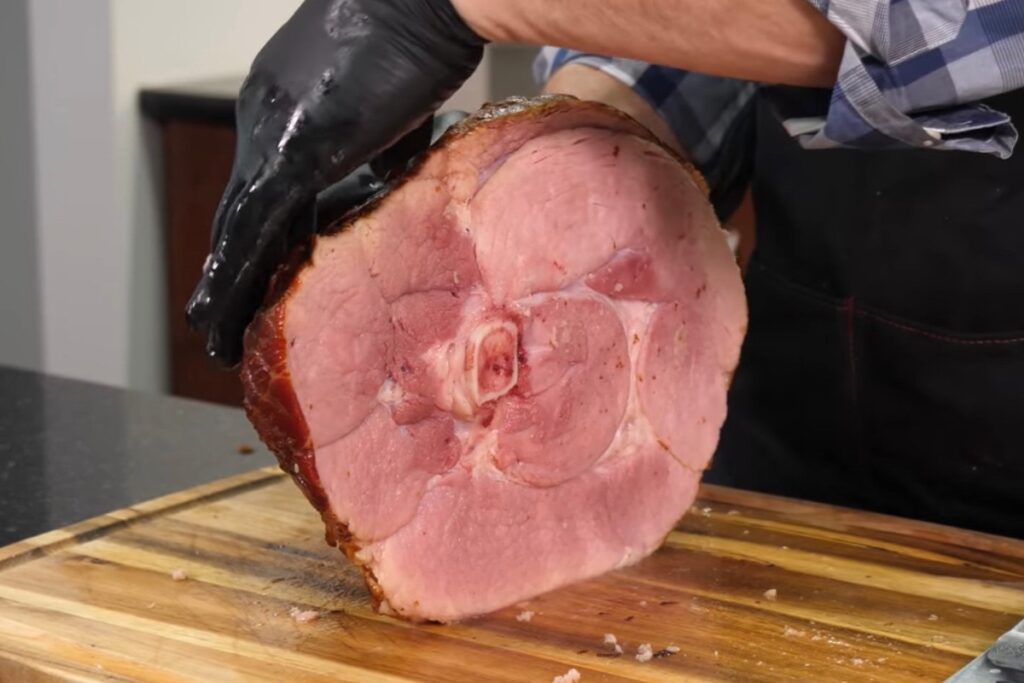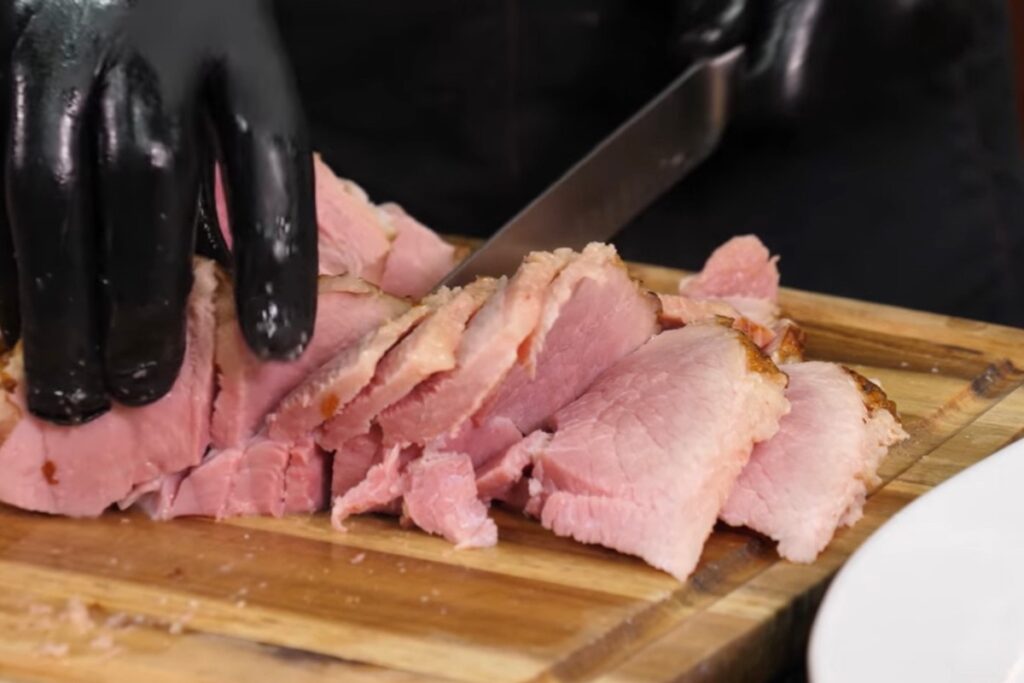The ham lovers of the world will tell you that there is nothing better than the richness of the flavor. However, there are many hams and cuts out there, and each of them have differences that either make them a favorite or hated.
In this post, we will be looking at shank ham and butt ham. There are fens on both sides, but in an objective competition, which one comes out on top?

If you want to find out a little more about these two types of hams and learn everything about them, stick around. We are going to be going through that these ham cuts are, where they can be found, and the differences between them.
What is Shank Ham?
Shank ham is known as the “king” of all hams. This cut comes from the pork leg, with bone in. It has been aged for weeks or months before it reaches its final resting place. Shank hams are usually smoked first and then cured with spices like pepper.
This cut of ham specifically comes from the shank bone, which is by the backside of the animal. The two muscles attached to this muscle are the biceps femoris and the semimembranosus muscles, which both attach to the hip joint.
The flavor of shank ham is very rich; however, it also tends to dry up faster since the meat is mostly lean. Because of its sheer size, this cut of ham can take over 40 days to cure properly.
Where Do You Find Shank Ham?
While shank ham varies depending on where you live, most regions have their own unique variations. Here are some places to look if your area does not sell shank ham commercially.
1.) A local butcher shop (if you have one) – Many butchers have access to local farms and buy directly from them. The quality of your ham will depend on how well cared for they were!
2.) Local farmer stand/farmers market – Most farmers markets carry shank hams. They may have their own unique names, so do your research.
3.) Grocery store, deli counter, or specialty market – With grocery stores, delis, and specialty markets being larger chains, you should know what type of ham you are getting. The quality of your shank ham will depend on who produced it.
4.) Online retail websites – Websites like MercadoLibre.com allow customers to order food online without having to leave their home. Once ordered, your ham will be delivered right to your doorstep.
How to Store Your Shank Ham?
Shank ham should be stored in the refrigerator. While there are no rules, generally speaking, smaller cuts dry out quickly when stored in the fridge. When storing your ham, keep it in the original wrapping.
If you remove this covering, you risk introducing bacteria into the meat. If you cannot refrigerate your ham right away, wrap it tightly in plastic or foil and keep it chilled until ready to use.
How to Cook Shank Ham?
When selecting shank ham for barbecuing, remember that unlike butt ham, shanks must have large pieces of skin around them. You do not want to get too close to the bone, leaving only thin slivers of meat on the outside. Therefore, you might consider purchasing a boneless piece off of the bone.
The bone adds flavor and helps protect the flesh against the harsh temperatures required during grilling. Although the bones add flavor, they are hard to chew once cooked.
If your shank ham has any remaining bone, you might consider removing it before cooking. To do this, hold the shank with tongs or tweezers and slide off each end of your shank ham.
Remove all excess fat by running your fingers over the top of your shank ham before heating up on the grill. This will help prevent the fats from burning onto your food.
Keep an eye on your shank ham as it cooks, turning every five minutes or so. It is normal to see some dark spots form — these areas indicate where the grease was burned onto the meat.
After it has been cooked fully, let it cool and serve.
What is Butt Ham?
Butt ham, on the other hand, is the name that is given to the butt-end of the pig. This cut is from the area where the body and the hind legs meet, including the tail and buttocks.
These cuts are typically sold whole. Butt ham’s flavor is slightly milder than that of shank ham. If you enjoy the flavors of lamb, you might love the taste of this cut.
Where Do You Get Butt Ham?
Just because a ham was called “butt” doesn’t mean it came from the butt itself. Butt ham actually refers to any ham that is taken from the butt of the pig. Here are some sources that sell butt ham.
1.) Butcher shops – Butchers can get this type of ham from suppliers.
2.) Farmer’s market – Some farmers markets sell raw ham. So, again, do your research and ask questions.
3.) Grocery stores – While grocers don’t necessarily sell butt ham, they do tend to stock these products. Ask them for information about butt ham.
4.) Specialty market -Many specialty markets carry this product. Just remember to ask where the butt ham came from prior to buying.
5.) Internet – Websites such as Amazon have a wide range of options when it comes to ordering different meats online. Butt ham is not the only option available. Check each website individually for their selection of product.
How to Store Your Butt Ham?

Since butt ham takes longer to prepare than shank ham, it needs additional time to rest before cooking. To make sure this happens, avoid over-cooking it by preparing it once per week. Here are some tips for storing butts.
1.) Temperature – Keep your butt ham at 40 °F (4 °C).
2.) Humidity – Avoid an overly humid environment. Let your butt ham dry out quickly if you live in the tropics.
3.) Time – Make sure to keep your butt ham away from strong smells such as garlic, onions, and spices. This will prevent it from spoiling prematurely.
It is best to cook butt ham within 6 months of purchase. As with other types of meat, the longer it sits after being cooked, the higher the chance of
Differences Between Shank Ham and Butt Ham
There are a few key differences between shank ham and butt (butt on the other side) ham. The primary difference is that shank ham has a higher percentage of fat content.
Shanks are often much fattier because of the extra layers of muscle tissue on their underside. The second significant difference is that, while shank ham takes a long time to cook, the butt ham finishes cooking quicker.
The third difference is that shank hams tend to take longer to cure than butt hams. However, with proper curing techniques, it is possible to make a high-quality shank ham within just a few weeks instead of months. Butt hams require more salt and less sugar in the brine, but still need about three weeks to cure.
Ham vs Fresh Pork – What is the Difference?
At this point, you might be wondering about pork. Since both ham and pork both come from pigs, are they the same thing? The answer is slightly more complicated than that. Pork is usually processed into sausage or bacon. It also often has less fat compared to ham. However, many people still call pork “ham” due to tradition.
However, when we talk about fresh pork, there is a difference between ham and pork. When pork is fresh, it is uncured and not preserved in brine, nitrates, or salt.
Ham, on the other hand, is cured in brines that contain salt. In addition, while most fresh pork comes from the shoulder or leg areas of the pig, ham can come from anywhere along the back, from neck down until the shoulder blade is reached.
Something to Know About Ham
Cuts of meat can be confusing to understand. Here, we are talking about butt ham, but a pig has two butts, right? Since the butt and shank are terms that refer to more than the ham, it can get confusing.
While you might remember that the lower segment is referred to as the shank, and the butt is located in the upper portion, this isn’t always the case. When a pork shoulder is smoked and cured, it then becomes a smoked shoulder or picnic ham.
All in all, the raw “pork butt” is, in reality, the top part of the shoulder. It’s confusing, but with the help of diagrams you will soon understand. Just make sure that you look at the correct diagram!
Identifying These Cuts
It is important to be able to identify any kind of cut of meat, and these two are no different. You can usually identify different meat cuts by their shape and size.
For example, if you see a big piece of meat, chances are good that it’s beef. If your butcher presents you with an odd looking slab of meat, you’ll want to ask questions like how old is it?
How was it treated before serving? Is it tender? Also, keep in mind how fresh the meat is. Older meats are generally tougher, so consider how you’re going to prepare them for maximum flavor.
Shank Ham
You can identify a shank ham because its main segments have large holes. That means that the meat connects easily, which makes carving easier. Shank ham can vary in thickness based on factors such as age and where it came from.
With younger animals, the entire leg is almost always used. However, older animals may only use half of the leg. Some producers even go through whole legs and remove everything except the bottom half. This is known as a bottom round.
In order to find out what type of ham you have, check to see if the meat resembles a thick steak (or possibly one made from tripe). Additionally, you should ask your butcher if you don’t recognize your piece.
Butt Ham
To identify a butt ham, you need to distinguish between the rib section and the loin area. The rib section is defined as the front of the ribs that extend from the shoulders to the sternum. The loin is the middle of the pig, extending from the breast region to just above the hip.
Finally, the butt is basically the last portion of flesh found below the rib section and above the loin. Think of it as a continuation of the hip bones.
Since the rib section contains a lot of lean meat, it tends to cook faster than anything else. Therefore, when making a roast, you should put smaller pieces of the rib section into the pan first. Remember to flip halfway during roasting to ensure uniform cooking throughout.
Pork Butt VS Butt Ham
Now, you will be wondering what the difference is between pork butt and butt ham. Well, these two are different because they are actually different types of hams, despite their similar names. Butchers often sell what they call a pork butt without labeling either as a shank or butt ham.
That said, you really aren’t missing much if there isn’t a label. In fact, some people like having a whole roasted pork butt, instead of just buying a regular butt ham.
Remember to keep the size in mind when purchasing a pork butt. A standard 8-pound American butt is considered small, whereas a 16 pound version is considered very large. It depends on the weight of the animal, but remember that larger breeds tend to yield bigger hams.
You can tell the difference between pork butt and butt ham by how the fat has been trimmed away. Butt hams typically have more visible fat than pork butt. Depending on how it was prepared, this extra fat could be delicious! Pork butt doesn’t come pre-trimmed, and therefore requires additional trimming after curing.
There is also a third category with no real name associated with it, called pork shanks. These are simply bone-in pieces of meat taken right off the backside of the pig. They are generally fairly fatty, so they would work well for a braised or stew.
The Shank VS Shoulder
Next is the difference between the shank and the shoulder. You can differentiate between these two by looking for the muscle patterning. Muscles running parallel to the centerline of the body are usually the lower extremities.
Shanks do not include any muscles coming down from the center line, while shoulders do. If you look at packaged cuts of meat, you’ll notice that all the dark lines are part of the shank, and none of them run along the midline of the body.
You might think that the shoulder comes from the upper arm, since both are connected by the collarbone. However, while they share the same bony structure, both are separate muscles. So when thinking about where your pork butts come from, pay attention to the muscles on the sides of the body.
Which is Healthier – Shank or Butt Ham?
An important thing to consider when comparing shank and butt ham is how healthy they both are. While no ham is considered to be very healthy, you want to make sure you don’t eat too many of them each week. They contain a high amount of saturated fats, which can increase cholesterol levels.
This doesn’t happen overnight; however, once you start eating lots of ham regularly, this condition may develop over time. Also, the bones found in a butt ham contribute more calcium to your diet, but shank bones contain more iron.
Both types of ham contain less sodium than other meats, but if you’re trying to lose excess weight, then your best bet is to choose leaner cuts of meat.
It’s okay if you want to treat yourself to some ham sometimes, but it definitely isn’t a good idea to make it a weekly habit and indulge too much. For the sake of your health, consuming any ham in moderation is always a good idea.
Which is More Versatile – Shank or Butt Ham?
In terms of versatility, shank ham is hard to beat. That is because its shape makes it perfect for cutting into smaller chunks. On top of that, unlike butt ham, shank ham can be cooked either way.
This means that you can add flavor to your dish before adding the salt, or vice versa. The result is that you get better overall taste without having to worry about getting burned afterwards. In contrast, butt ham must be cooked first before seasoning, thus losing out on those vital flavors.
Also, shank ham should be cooked in liquid until completely tender before serving to create a sauce. This will prevent dryness on the inside of the piece. With butt ham, there is a chance that it won’t cook through as thoroughly, thus becoming tough.
To avoid such problems, people should cut up the ham and pan fry until browned, then finish cooking at high heat.
So, ultimately, it depends on what your preference is. Either one can work well for your needs, so it really just boils down to personal choice.
Final Thoughts – Who Should Wear the Ham Crown?
If you came here looking for a definitive answer, you will never find it. It’s clear that shank ham is the more popular choice since it’s healthier, versatile, and flavorful. Butt ham does have its benefits; especially with regard to convenience and ease of preparation.
Ultimately, it comes down to personal preference! There can never be a single winner (but it would be shank ham if there was a fight to the death). As everyone’s preferences are so varied, there will always be people who will prefer one over the other for whatever reason, and the other doesn’t make the cut.
In the end, it is worth trying these cuts for yourself to determine which one will wear the crown in your kingdom. Now, get out there and get tasting!
- Porterhouse Vs. Ribeye - May 16, 2022
- How Long To Smoke A Brisket Per Pound – Explained - May 16, 2022
- What Is A Tomahawk Steak? - May 16, 2022








